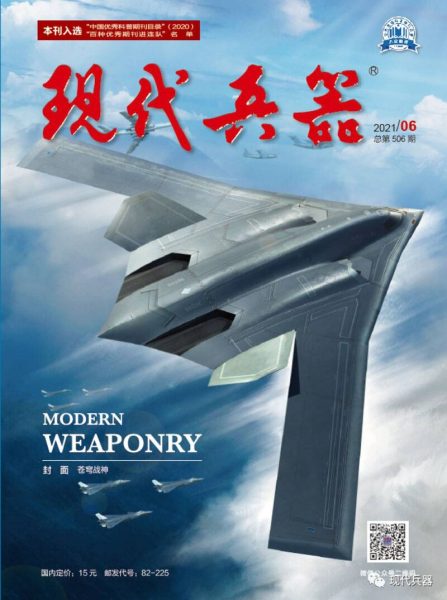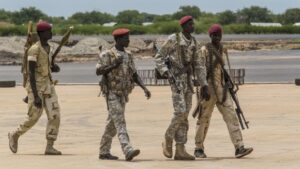This article first appeared on Warrior Maven, a Military Content Group website.
(Washington D.C.) China’s emerging “B-2 copycat” H-20 stealth bomber is expected to introduce an entirely new sphere of threat dynamics to the U.S., as it further cements China’s nuclear triad and massively extends its nuclear attack range to include major portions of the continental U.S.
While there is much still to be known about the H-20, there are many reasons why U.S. weapons developers are likely to take it very seriously. For instance, if the H-20 can extend its range beyond the first Island Chain off the coast of China, then it could not only hold the Philippines, Japan and areas of the South China Sea at risk, but also threaten Guam, a US territory. Certainly if extended with a refueler, the H-20 might be in position to threaten Hawaii or even parts of the continental US.
The Pentagon’s “China Military Power Report.” report as far back as 2018 and 2019 said China’s new H-20 long-range stealth bomber would potentially introduce paradigm-changing threats as it is expected to operate with an 8,500km range. This would hold key, previously unreachable areas of the US at risk in new ways.
A reported range of 8,500km appears slightly less than a B-2 bomber’s range of more than 6,700 miles. However, Pentagon reports have raised concerns that the Chinese “may also be developing a refuelable bomber that could “reach initial operating capability before the long-range bomber.”
Perhaps of even greater concern, the Pentagon assessment states, is that such a refueler could “expand long-range offensive bomber capability beyond the second island chain.” A refueler could also substantially change the equation and enable it to rival the mission scope of a B-2 which, as many know, successfully completed 44-hr missions from Whiteman Air Force Base in Missouri to Diego Garcia, a small Island off the Indian coast during Operation Enduring Freedom in Afghanistan.
Added to this threat equation, a report from the London-based Royal United Services Institute for Defence and Security Studies report writes that the state-of-the-art H-20 can carry a massive weapons payload of 45 tonnes and fly great distances without mid-air refueling.”
This article first appeared on Warrior Maven, a Military Content Group website.
(Washington D.C.) China’s emerging “B-2 copycat” H-20 stealth bomber is expected to introduce an entirely new sphere of threat dynamics to the U.S., as it further cements China’s nuclear triad and massively extends its nuclear attack range to include major portions of the continental U.S.
While there is much still to be known about the H-20, there are many reasons why U.S. weapons developers are likely to take it very seriously. For instance, if the H-20 can extend its range beyond the first Island Chain off the coast of China, then it could not only hold the Philippines, Japan and areas of the South China Sea at risk, but also threaten Guam, a US territory. Certainly if extended with a refueler, the H-20 might be in position to threaten Hawaii or even parts of the continental US.
The Pentagon’s “China Military Power Report.” report as far back as 2018 and 2019 said China’s new H-20 long-range stealth bomber would potentially introduce paradigm-changing threats as it is expected to operate with an 8,500km range. This would hold key, previously unreachable areas of the US at risk in new ways.
A reported range of 8,500km appears slightly less than a B-2 bomber’s range of more than 6,700 miles. However, Pentagon reports have raised concerns that the Chinese “may also be developing a refuelable bomber that could “reach initial operating capability before the long-range bomber.”
Perhaps of even greater concern, the Pentagon assessment states, is that such a refueler could “expand long-range offensive bomber capability beyond the second island chain.” A refueler could also substantially change the equation and enable it to rival the mission scope of a B-2 which, as many know, successfully completed 44-hr missions from Whiteman Air Force Base in Missouri to Diego Garcia, a small Island off the Indian coast during Operation Enduring Freedom in Afghanistan.
Added to this threat equation, a report from the London-based Royal United Services Institute for Defence and Security Studies report writes that the state-of-the-art H-20 can carry a massive weapons payload of 45 tonnes and fly great distances without mid-air refueling.”
While the exact composition of its stealth properties or radar-signature-reducing technologies may not be fully known, available photos and renderings reveal an aircraft, which one could say seems in some respects to be indistinguishable from a U.S. B-2. There is nothing surprising about this, given China’s well known and well-documented habit of attempting to steal or copy U.S. weapons designs, it seems particularly apparent in the case of the H-20. It features a similar rounded upper fuselage, blended wing body, curved upper air inlets and essentially no vertical structures. There appears to be a fair amount of evidence, simply available to the naked eye, to demonstrate China’s potential “copycat” maneuver.
The B-2 is known for its long-endurance flights as well; during Operation Enduring Freedom in the opening days of the Afghan war, U.S. B-2 flew 44-hour missions from Whiteman AFB, Miss., to Diego Garcia, a small island off of the Indian coastline. From there, B-2s flew bombing missions over Afghanistan in support of U.S. ground forces.
While this mission likely required refueling, it does speak to the merits and tactical advantages of long-endurance bombing.
It is also not clear if the H-20 could succeed in rivaling a U.S. B-2 given the extent of upgrades and adaptations the Air Force has undertaken with the 1980s platform. The B-2 will soon have air-defense evading Defensive Management Systems sensors, a thousand-fold faster computer processor and weapons upgrades to include an ability to drop the B-61 Mod12 nuclear bomb. The B-2, which is expected to fly alongside the new B-21 until sufficient numbers of B-21s arrive, will be a much different plane in a few years when compared to its 1980s origins, as the Pentagon hopes to ensure the platform remains relevant and powerful for many years into the future.
The Pentagon’s 2019 China report cites 2016 public comments from People’s Liberation Army Air Force Commander General Ma Xiaotian announcing the development of the H-20, and saying the weapon could emerge sometime in the next decades. Well sure enough, the next decade is here and early renderings appear to parallel some of Xiaotian’s comments about Chinese intentions for the bomber. According to the Pentagon’s China report, he said the H-20 will “employ 5th generation technologies.”
An ability to engineer and deliver 5th-gen systems into the bomber may remain to be seen to some extent, as much is still unknown, yet the Chinese have already engineered several potentially 5th-gen aircraft with the J-20 and J-31. At very least, the exterior does appear to be stealthy; it looks like it has an embedded engine, blended wing body, absence of vertical structures and engine air ducts woven into the frame underneath the fuselage. The B-2, by contrast, has air ducts emerging from the top of the fuselage, however many design features unequivocally seem to resemble a B-2. The Pentagon report observed that “a possible H-20 prototype depicted a flying wing airframe akin to the B-2 bomber and X-47B stealth unmanned combat aerial vehicle.”
While much is not known about the H-20 bomber, its external configuration and horizontal blended wing-body resembles a US B-2 or B-21. As for its ability to compete with a B-2 or B-21, there may simply be too many unknowns. However, a few things do come to mind. The B-21 airframe for instance, appears to have little or almost no external exhaust pipes, raising the question as to whether it incorporates new thermal management or heat dispersion technologies. A key goal, when it comes to designing stealth bomber airframes, is to work toward having it mirror or align with the surrounding temperature of the atmosphere so as to be less detectable to thermal sensors. Also, while much of the B-21’s details remain “black” for understandable reasons, senior Air Force leaders have said the platform contains a new generation of stealth technologies and can “hold any target at risk in the world at any time.”
This indicates that there may be a high measure of confidence that the new B-21 will be able to succeed against the most advanced current and anticipated future air defense systems. An ability to elude both surveillance and engagement radar in a modern technical environment would be quite an accomplishment, as advanced Russian air defenses such as the S-400 and S-500 contain a new generation of technologies. Not only do they use digital networking to connect radar nodes, rely upon faster computer processing and track aircraft on a wider sphere of frequencies, but they also claim to be able to detect “stealth” to a large degree.
This may remain as of yet unproven, as it is something touted by the Russian media, yet it has inspired U.S. weapons developers to seek newer paradigms for stealth technology. Also, the sophistication of these advanced air defenses may be one reason why, at least when it comes to stealth fighters, senior Air Force weapons developers describe stealth as merely “one arrow in a quiver” of methods to evade and destroy enemy air defenses. Nonetheless, there is no available evidence to suggest a new B-21 would have any difficulty against the most advanced air defenses; debates along these lines are likely to persist for years, at least until much more is known about the B-21. Air Force officials say the B-21 will be virtually “undetectable,” something which may very well be true.
Finally, it may not even be clear that China’s new H-20 bomber could even fully rival the U.S, B-2. While the B-2 may be thought of as a somewhat antiquated 1980s built platform, years of Air Force upgrades have vastly changed the performance parameters of the airplane. The B-2 is now being engineered with a so-called Defensive Management System sensor designed to find locations of enemy air defenses — and thus fly around them. The B-2 is also being outfitted with a new 1,000-fold faster computer processor and being configured to integrate new weapons platforms such as the modern, upgraded B-61 Mod12 nuclear bomb. Finally, much like what is reported about the H-20, both the B-2 and B-21 are engineered to carry and fire long-range nuclear and conventional cruise missiles, such as the Air Force’s emerging Long Range Standoff Weapon.
Overall, the current B-2, which is now being engineered to fly alongside the B-21 until sufficient numbers of B-21s are available, is nothing like the aircraft that initially emerged in the late 80s. Along these lines, both the B-21 and B-2 are built with the often discussed “open architecture” strategy intended to lay down the technical apparatus sufficient to sustain perpetual upgradeability.



